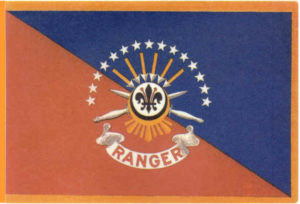Battle Honors Flag

World War II Rangers
The dark area represents the United States.
The red (scarlet) area represents Great Britain where the Ranger organizations were activated and trained.
The combined blue and red thus symbolizes the close association in both training and combat of the Rangers and the British Commandos.
The fifteen stars refer to the fifteen campaigns, World War II, in which the Rangers participated.
The six spearheads allude to the six Ranger Battalions and also to the six assault landings (invasions) in which the Rangers took part.
- the white disc alludes to Central Europe (Germany)
- the black lily to France, and the Low Countries
- the red seed pods represent Italy
- the double crescent refers to Algeria and Tunisia
- the three sun rays (similar in design to those depicted on the Philippine flag) allude to the Philippines and New Guinea
The crossed Ranger (Sykes) knives suggest the nature of the Ranger operations.
Designed by U.S. Army Heraldic Branch
A.G., Department of the Army
In the words of a World War II Ranger
The Ranger Battle Honors Flag represents the proud and enduring record of the six United States Army Ranger Battalions in World War II. The Rangers of all six battalions are equally as proud of the achievements of each and every Ranger Battalion as they are their own.
The Ranger philosophy for winning battles was tough, realistic training inspired leadership, detailed planning, thorough reconnaissance, contact, coordination, and control, hit the enemy where he least expects it, choose the most difficult route of approach, attack at night with speed, surprise and shock, carry through relentlessly. These concepts were proven in battle after battle.
The record speaks for itself. The Rangers spearheaded every major invasion of World War II-the first to land, the first to die, the first to capture the enemy's defenses and make it possible for other troops to land and broaden the beachheads. Fifteen campaigns, innumerable battles and engagements, raids and sorties-and who can keep track of the countless combat patrols and night infiltrations that were never mentioned in the daily communiqués?
But the battle records of the six Ranger Battalions do not tell the full story of the American Ranger in World II. The spirit that each Ranger carried in his breast-that drove him to accomplish the impossible, that inspired him to attack the most formidable enemy defenses, that enabled him to endure in campaign after campaign, that compelled him to excel as as American soldier, this is the most important part of the Ranger story that is represented on our Battle Honors Flag.
We, who were privileged to have served with the Rangers know what spirit was. It was a spirit that was formed by many essential elements. Leadership by example, mutual respect and esteem, concern for our fellow Rangers, teamwork, pride in our units, a comprehension of why we were fighting, the will to win, not at all costs, but by skill, preparation, and ingenuity. The Ranger spirit was a mixture of individuality tempered by self-discipline and directed toward the achievement of the common objectives of victory. The Ranger spirit was audacity, daring, and originality. It was resourcefulness and versatility. It was a positive force. It was, in essence, the spirit that has kept liberty alive since time immemorial-the willingness to give of yourself to a common cause-above and beyond one's obligation as an American citizen.
The Ranger spirit is an important part of our National Heritage, and each Ranger who fought with the six Ranger Battalions, helped make that heritage stronger and significant. We are mindful that we, as custodians of that spirit, have a serious obligation not only to keep the spirit alive, but to keep it vigorous and strong and to direct that spirit towards positive good for our country today.
- James Altieri
1st & 4th Ranger Battalion
 DESCENDANTS OF WWII RANGERS, INC
DESCENDANTS OF WWII RANGERS, INC 